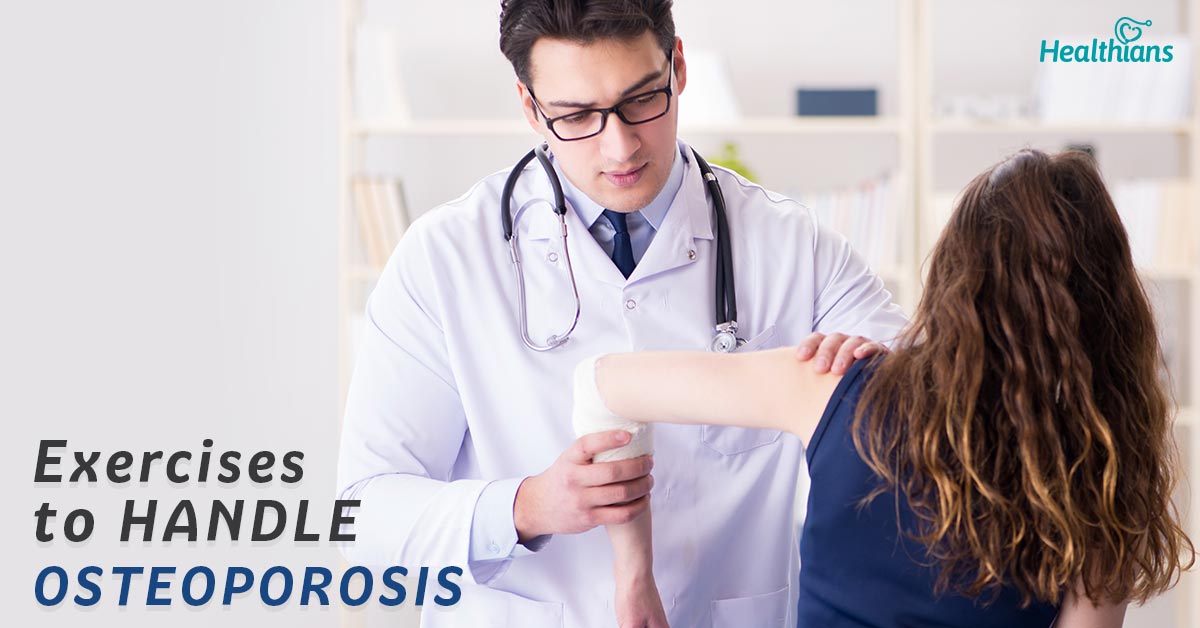Contributed by – Healthians Team
Osteoporosis, a word which is commonly used by aged ladies, is not just often heard, but its occurrence is highly prevalent too. As the name itself suggests, “Osteo” means bones and “porosis” means porous. In this, the mineral density of the bone goes so low that they become porous, fragile and weak.
Commonly caused in ladies, due to the strong link between bone density and other hormones in the body; it occurs mostly in post-menopausal women. Hence, it is recommended by doctors that women (in this age bracket) should keep a check on their hormone levels. The major bones where osteoporosis occurs are the weight-bearing ones, like the hip joint and the spine. The low mineral density due to osteoporosis along with bodyweight makes women more prone to fractures even with slight strenuous activity.
For the same reason, dieticians and doctors recommend a calcium-rich diet with an equal amount of Vitamin D (to synthesize the calcium in the body). Also, regularly monitoring the levels of both calcium and Vitamin D is suggested to all women after 40. Along with this, essential reforms in diet and an exercise plan should be strictly followed to prevent one from falls. Also, maintaining a healthy Bone Mass Density is important which can be achieved with dedicated training, enabling you to build and maintain the amount and thickness of your bones.
Here is a list of frequently asked questions about osteoporosis.
What are the benefits of exercise in osteoporosis?
Whether you have osteoporosis or not, the benefits of exercise are immense. Regular exercise improves health in many ways. People who exercise regularly tend to have lower rates of depression, heart disease, dementia, cancer, diabetes and many other chronic diseases. Exercise can improve your physical fitness, strength, energy levels, stamina, and mental health.
But here when talking about bone health and strength, it will:
- Increase your muscle strength
- Improve your balance
- Decrease your risk of bone fracture
- Maintain or improve your posture
- Relieve or reduce pain
What kind of exercises should be done?
All the activities that you include in your plan should aim at increasing your muscular strength and density of the bone. This can be achieved by mild exercises like walking, dancing, stair climbing, jogging and brisk walking. Resistance training can be performed which aims at increasing your muscular strength and can include lifting weights, using elastic exercise bands, using weight machines, lifting your body weight, functional movements, such as standing and rising on your toes. There are exercises which aim at increasing the balance. Hence, adding yoga to your daily routine activity shall prevent one from falling and achieving a better balance.
Should I seek the help of a trainer?
Yes, you should train under an expert only. You should always consult a medical practitioner who shall guide you of all the things which should not be done if you have any other underlying medical condition.
How long will I have to exercise?
If you have weak bones and are at risk of developing osteoporosis, then you should make exercising a part of your daily living as the levels of vitamin D and calcium continue to fluctuate.
What should I include in my plan?
An exercise plan, if designed by a trainer, shall cover all your areas where bone density is minimum. Start with a warm-up session which shall make the muscles soft and warm for an easy stretch. Following this, mild weight-bearing exercise, resistance training exercises and easy yoga stretches which are covered below should be included.
Are there any exercises that should be avoided?
Yes, activities that include direct weight-bearing with a thrust should be strictly avoided like jumping, skipping, push-ups, or planks.
Is yoga beneficial for people with osteoporosis? How does it help?
Yoga has said to be a healthy way of living for ages. It helps those suffering from osteoporosis by increasing their bone strength and prevents people from having it too. Hence, it is important for people suffering from osteoporosis to keep a constant check on their bone strength to gauge the effectiveness of their yoga regime.
Are there any specific yoga asanas that can help?
Yoga, when done under proper guidance, will give immense benefit to those suffering from osteoporosis. Asanas like Utrangasana, Vrishkhasana, Trikonasana, Virabhadrasana and Adho Mukha Svanasana are best prescribed for osteoporosis.
Are there are any side effects of doing yoga while managing osteoporosis?
You should start yoga under the guidance of a yoga trainer and discuss your medical history as well. A few yoga poses should be avoided in osteoporosis because overstretching can damage the bones. Hence, avoid Chaturanga or jumping poses.
How can yoga benefit bone health?
Yoga gives a better sense of balance and coordination. It provides weight training and muscle strength which increases bone mineral density by creating better bone health and strength.
Will yoga also help those at an advanced stage of osteoporosis?
Yoga has shown immense benefit to those who have been doing it as a daily regime. Those in the advanced stage of osteoporosis should start yoga to prevent further deterioration and for effective pain management.
Are there any other benefits of yoga?
Yoga enables an individual to have a relaxed mind and body. With the advantages of improving bone health, it helps them to improve levels of hormones, blood pressure, thyroids, sugar and digestion too.
Does age/gender limit the benefits?
Yoga helps all age groups and genders. Though, gender-specific health issues can have different asanas to perform by males and females.
Exercises not just help your muscles but also help you to have a shaped and toned body. Bones become stronger if we follow a “healthy diet” and have “sufficient levels of vitamins”.




